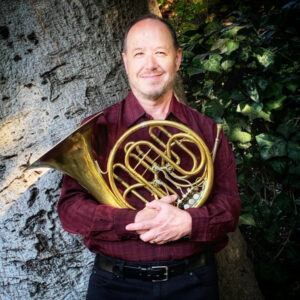Why do contemporary horns look and sound the way they do, and when did they start looking and sounding that way? On Saturday, January 23, San Francisco Symphony hornist Jonathan Ring will answer those questions during what’s sure to be a lively and informative online workshop on the history of horns from hunting fields to concert hall. We caught up with Jonathan at his home in Piedmont to learn more about the twisty saga of the modern horn—and about how he became an accidental horn historian.
Let’s start with your own background. How did you become a hornist?
I grew up in Miami with two siblings, and we all played instruments, but I’m the only one who made music a career. We all started on the piano—our mother was a really fine pianist who’d gone to the Eastman School of Music. Dad was an ophthalmologist and amateur cellist, so I tried cello for a while, too. I also played percussion and then trumpet. I switched to horn when I was 13. It was a little contrarian of me. So many kids were playing trumpet, and they needed a horn player, and I thought “That’s different!” I played in school band and youth orchestras.

Horns have been around since antiquity—in the beginning they were literally animal horns. Beginning around the middle of the 19th century we saw many new types of brass horns. What accounts for that creative explosion?
The big event was the invention of the valve. Over the years different technologies were tried, in fits and starts, and between 1820 and 1830 we got the first really successful valve designs. Before then, you had to manipulate your hand inside to bell to get any sort of chromatic notes, and soloists and orchestral players were very adept at this technique. Valves were a technological change, but also a major change to sound of the instrument because they eliminated the closed notes. This change was welcomed by a lot of people, but others thought something important was being lost.
Once the valve came along, it was sort of the Wild West. People asked themselves, How do we implement that? There was no standardization. Instrument designers tried all these interesting ways of integrating the new technology into the instrument. They tried piston valves, rotary valves, and different tubing layouts. It was a cool time because of all the experimentation! Some instruments emphasized artistry of design while others were focused on practicality.
How did we end up where we are today?
By 1900 there were three main designs, and a horn player today usually will use one of the three. Most of the advances came from Germany, where the Kruspe, Alexander, and Schmidt companies were the principal influences. A Schmidt employee, Carl Geyer, came to the United States in 1904 and became a famous horn maker in Chicago. I play a Geyer instrument, as do most of the the San Francisco Symphony’s horn players.
Why should horn players learn about horn history?
I started getting interested in horn history about five years ago. The more I learned, the more it influenced my playing. If I’m playing a piece written in France in the 1920s, the horn it was written for was completely different from the horns being played at that time in Germany or Vienna, and certainly in the U.S. Ravel and Debussy’s concept of the horn influenced how they wrote music for the instrument. It’s incumbent on me as an interpreter of their music to learn from the past and bring that knowledge to my playing.
During a 2016 San Francisco Symphony tour, Jonathan Ring reunited his 1941 Geyer horn with its original owner, Lloyd Silver. Watch the reunion.
